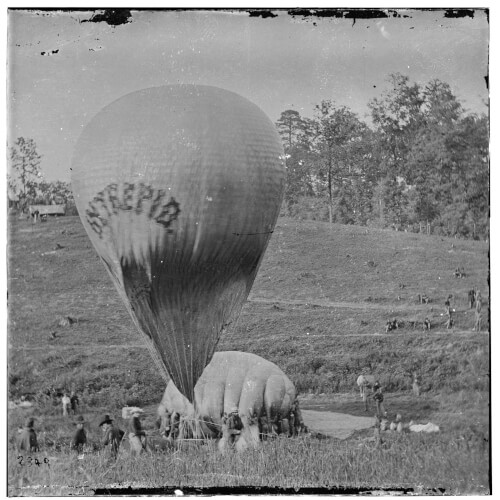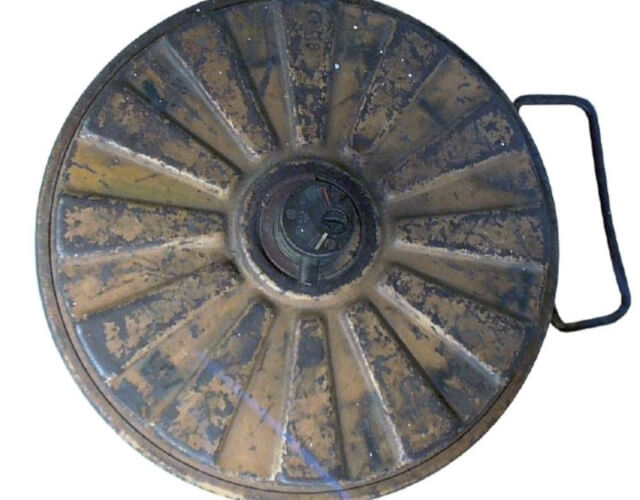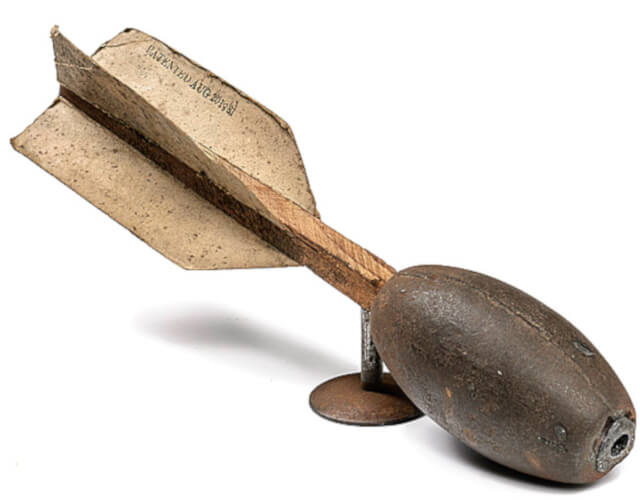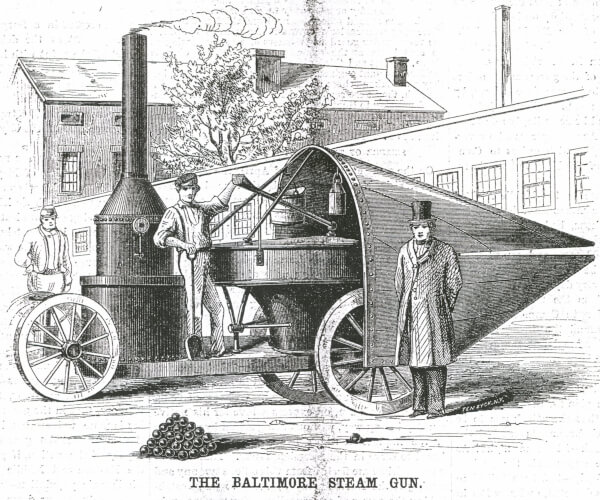Civil War Arms and Equipment
Exploring the weapons and technology of the Civil WarMiscellaneous Civil War Weapons
In addition to being a period of great political upheaval, the Civil War was a time of great technological change. In addition to improving existing weapons to be more accurate and deadly, a variety of new weapons emerged. Everything from repeating rifles to landmines and hand grenades were developed in an effort to gain an edge against the enemy. These new technologies and weapons would change the face of war and force commanders to change tactics used on the battlefield and the way wars were fought.
Hot Air Balloons
The Civil War saw the first effective use of balloons for reconnaissance by tethering them to the ground and running telegraph wires up to the basket. The Union even had an official Balloon Corps headed by “Chief Aeronaut” Thaddeus Lowe. During the First Battle of Bull Run, the Battle of Fredricksburg and the Battle of Chancellorsville, Lowe launched his balloons and provided important information on troop movements and positions back to commanders in realtime. He was also able to direct artillery fire from high above the field.
The Confederates also made an attempt at arial reconnaissance. Due to the fact the South had limited resources, they were not as successful. They were able to create one balloon from silk but it was captured after the tugboat carrying it ran aground on the James River
Land Mines
Developed by Confederate General Gabriel Rains, land mines, sometimes called “torpedoes,” was an antipersonnel explosive that was made from an iron container that was rigged with gunpowder, a fuse and a brass detonation cap. These landmines were first used in 1862 during the Peninsula Campaign and later in the war thousands were placed around the city of Richmond, Virginia.
Not everyone was in favor of the use of landmines. Union General George B. McClellan denounced them as “barbarous,” and Confederate General James Longstreet briefly banned their use. Union General William Sherman called the use of landmines as “not warfare, but murder” after losing troops to the hidden devices.
Hand Grenades
In addition to other weapons, the Civil War saw advances in the design and manufacture of hand grenades. The most popular model was the Union-issued Ketchum grenade, a projectile explosive that was thrown like a dart. The grenades came in one-, three- and five-pound models equipped with stabilizer fins and a nose-mounted plunger. Upon impact, the plunger would detonate a percussion cap and ignite a deadly supply of gunpowder.
Winans steam gun
Built by William Joslin and Charles Dickinson, the Winans steam gun was one of the more unusual weapons to come out of the Civil War. This massive automatic weapon sat on an armored train carriage and used steam to supposedly fire bullets at a rate of 200 a minute. Unfortunately, the gun was never used in combat. In May 1861, Union forces captured Dickinson as he was headed to Haper’s Ferry to sell his invention to Confederates. The Union army never tried to use the gun in battle and the gun was sent to Fort Monroe in Virginia and then further north to be scrapped.
Other Strange Weapons
Coffee Mill Gun
The Coffee Mill Gun was similar to the Gatling gun, just not a popular. This gun was a hand-cranked weapon that fired .58 caliber cartridges at a rate of 120 rounds per minute. After President Lincoln attended a demonstration in 1861, War Department ordered 60 of guns.
US War Department then acquired 60 of these coffee mill guns. Unfortunately, Union commanders felt that the gun wasted too much ammunition. Another downside to the gun was that the barrel would quickly overheat and the hopper-fed cartridges would frequently jam. This led to the fun seeing little action and limited deployment in the field.
Double Barrel Cannon
The double barrel cannon was designed in 1862 and resembled a double barrel shotgun. This cannon featured two barrels that were joined together for the purpose of simultaneously firing two 6lb shells that were linked by a chain.
The idea was that both of these barrels would fire off simultaneously, and send the chain-shot into enemy combatants. Sadly, the very first field test of this prototype was a total disaster. The barrels didn’t fire off at the same time, which caused the chain-shot to go off target wildly.
Coal Torpedo
The coal torpedo was a gunpowder bomb that resembled a piece of coal and was designed by Thomas Courtenay in 1864. The bomb was used by the Confederates agains Union vessels. The bombs were smuggled into coal supplies in ships and when workers stoked the furnace, the bombs exploded. Two ships are known to have been damaged by coal torpedo detonations. Another sabotage attempt was made against the Springfield Armory by putting a timing fuse on a coal torpedo, but the bomb was discovered in time.
Armored Rail Car
In an effort to protect the railways and bridges from Confederate attacks, the US government ordered the creation of armored railroad cars. These cars were created by taking a boxcar and then fitting it with thick sheets of iron on the sides and top. To provide ventilation and the ability to shoot, several holes were drilled into the sides of the cars. These armored cars allowed for up to 50 men inside to fire at an enemy. Some cars also held small cannons. In 1864, a Confederate cannon shot demolished one of these armored railroad cars. Another one got destroyed in 1865. Some of these cars were even captured by the Confederates.
Learn More
Videos
Vocabulary
Armored – covered with a tough metal layer as a defense against attack.
Arial reconnaissance – reconnaissance for a military or strategic purpose that is conducted using reconnaissance aircraft.
Grenade – an explosive weapon typically thrown by hand
Reconnaissance – military observation of a region to locate an enemy or ascertain strategic features.




